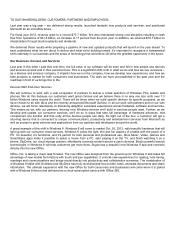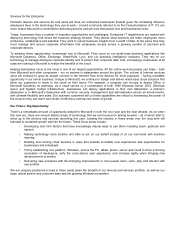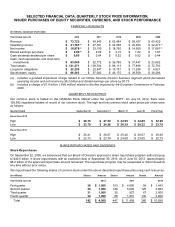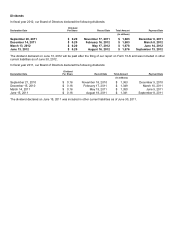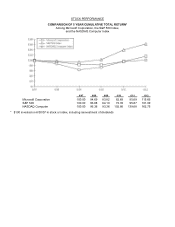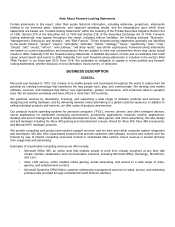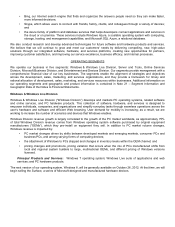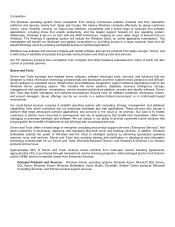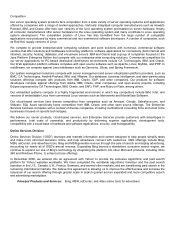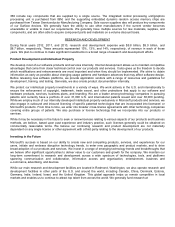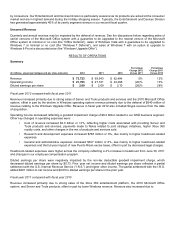Microsoft 2012 Annual Report Download - page 11
Download and view the complete annual report
Please find page 11 of the 2012 Microsoft annual report below. You can navigate through the pages in the report by either clicking on the pages listed below, or by using the keyword search tool below to find specific information within the annual report.Competition
Our server operating system products face competition from a wide variety of server operating systems and applications
offered by companies with a range of market approaches. Vertically integrated computer manufacturers such as Hewlett-
Packard, IBM, and Oracle offer their own versions of the Unix operating system preinstalled on server hardware. Nearly
all computer manufacturers offer server hardware for the Linux operating system and many contribute to Linux operating
system development. The competitive position of Linux has also benefited from the large number of compatible
applications now produced by many commercial and non-commercial software developers. A number of companies, such
as Red Hat, supply versions of Linux.
We compete to provide enterprise-wide computing solutions and point solutions with numerous commercial software
vendors that offer solutions and middleware technology platforms, software applications for connectivity (both Internet and
intranet), security, hosting, database, and e-business servers. IBM and Oracle lead a group of companies focused on the
Java Platform Enterprise Edition that compete with our enterprise-wide computing solutions. Commercial competitors for
our server applications for PC-based distributed client/server environments include CA Technologies, IBM, and Oracle.
Our Web application platform software competes with open source software such as Apache, Linux, MySQL, and PHP. In
middleware, we compete against Java middleware such as Geronimo, JBoss, and Spring Framework.
Our system management solutions compete with server management and server virtualization platform providers, such as
BMC, CA Technologies, Hewlett-Packard, IBM, and VMware. Our database, business intelligence, and data warehousing
solutions offerings compete with products from IBM, Oracle, SAP, and other companies. Our products for software
developers compete against offerings from Adobe, IBM, Oracle, other companies, and open-source projects, including
Eclipse (sponsored by CA Technologies, IBM, Oracle, and SAP), PHP, and Ruby on Rails, among others.
Our embedded systems compete in a highly fragmented environment in which key competitors include IBM, Intel, and
versions of embeddable Linux from commercial Linux vendors such as Metrowerks and MontaVista Software.
Our cloud-based services face diverse competition from companies such as Amazon, Google, Salesforce.com, and
VMware. SQL Azure specifically faces competition from IBM, Oracle, and other open source offerings. The Enterprise
Services business competes with a number of diverse companies, including multinational consulting firms and small niche
businesses focused on specific technologies.
We believe our server products, cloud-based services, and Enterprise Services provide customers with advantages in
performance, total costs of ownership, and productivity by delivering superior applications, development tools,
compatibility with a broad base of hardware and software applications, security, and manageability.
Online Services Division
Online Services Division (“OSD”) develops and markets information and content designed to help people simplify tasks
and make more informed decisions online, and help advertisers connect with audiences. OSD offerings include Bing,
MSN, adCenter, and advertiser tools. Bing and MSN generate revenue through the sale of search and display advertising,
accounting for nearly all of OSD’s annual revenue. Expanding Bing beyond a standalone consumer search engine, we
continue to expand our use of Bing’s technology by integrating the platform into other Microsoft products, including Xbox
360 and Windows Phone, to enhance those offerings.
In December 2009, we entered into an agreement with Yahoo! to provide the exclusive algorithmic and paid search
platform for Yahoo! websites worldwide. We have completed the worldwide algorithmic transition and the paid search
transition in the U.S., Canada, U.K., France, Germany, and several other markets, and are transitioning paid search in the
remaining international markets. We believe this agreement is allowing us to improve the effectiveness and increase the
relevance of our search offering through greater scale in search queries and an expanded and more competitive search
and advertising marketplace.
Principal Products and Services: Bing; MSN; adCenter; and Atlas online tools for advertisers.


